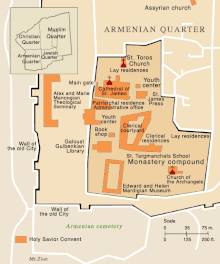Patriarchate of Jerusalem of the Armenian Apostolic Church
The Patriarchate of Jerusalem is the Archdiocese of Jerusalem of the Armenian Apostolic Church . Until 1929 the Armenian dioceses in Syria, Lebanon, Cyprus and Egypt belonged to the Jerusalem Patriarchate; then the Catholic of Cilicia took care of them.
The Patriarchate is the guardian of the Armenian Holy Places in Jerusalem, responsible for the Armenian Community of the Holy Land and looks after the Armenian pilgrims to the Holy City.
The Patriarchal Cathedral is the St. James Church in the Armenian Quarter of Jerusalem's Old City , where the skull of the Apostle James is kept (other relics of this disciple of Jesus are venerated in the Cathedral of Santiago de Compostela ).
Besides two other Christian denominations, the Armenians have a share in the Church of the Holy Sepulcher , the holiest place in Christianity. The Armenian Apostolic Church has recognized the rights of the Syriac Orthodox and the Coptic Church .
history
According to an interpretation that has been widespread since the 18th century, the patriarchate emerged from the opposition of the Jerusalem Armenians to the Rome-friendly and Latinizing resolutions of the Synod of Sis in 1307 in the Kingdom of Lesser Armenia . Bishop Sargis (Sarkis) of Jerusalem (term 1281-1313) was, it is said, the Catholicos collected the Armenians and gained recognition in 1311 as patriarch by his sovereign, the Mamelukes -Sultan Malik Nasr. Sources for this claim are lacking. Despite all reservations about the unification of the Cilician Armenians with Rome, there was historically no formal break between Jerusalem on the one hand and the Catholic of Sis and the Armenian kings of Lesser Armenia on the other. In the 15th and 16th centuries, the Jerusalem Patriarchate maintained close relations with the Catholic of Cilicia and only came under the jurisdiction of the “Catholicos of All Armenians” in Etschmiadzin in the 19th century . Because of the afflictions of the other three centers (Etschmiadzin, Constantinople / Istanbul, Sis / Antelias), the Patriarchate in Jerusalem formed the unofficial center of the Armenian Church in the 1930s.
Present situation
The Armenian Christians in the Holy Land form four parishes: Jerusalem, Bethlehem, Jaffa and Haifa. The church in Jerusalem is larger than the other Armenian churches.
See also
literature
- Michael E. Stone, Roberta R. Ervine, Nira Stone (eds.): The Armenians in Jerusalem and the Holy Land (= Hebrew University Armenian Studies. Vol. 4). Peeters, Leuven et al. 2002, ISBN 90-429-1078-X .
- Claude Mutafian: Prélats et souverains arméniens à Jérusalem à l'époque des croisades: legends et certitudes (XIIe – XVe siècle). In: Studia Orientalia Christiana. Vol. 37, 2004, ISSN 0585-5403 , pp. 109-151, doi : 10.1484 / J.SOCC.3.256 .
- Claude Mutafian: Les Arméniens et Jérusalem au Moyen Age. In: Revue Arménienne des Questions Contemporaines. Vol. 4, 2006, ISSN 1769-8316 , pp. 9-18.
- Thomas Maier: L'Eglise Arménienne de Jérusalem. Histoire et actualité. In: Proche-Orient Chrétien. Vol. 57, 2007, ISSN 0032-9622 , pp. 58-76.
- Sergio La Porta: The Armenian Episcopacy in Mamluk Jerusalem in the Aftermath of the Council of Sis (1307). In: Journal of the Royal Asiatic Society. 3rd series. Vol. 17, 2007, ISSN 1474-0591 , pp. 99-114, doi : 10.1017 / S1356186307007110 .
- Avedis K. Sanjian: The Armenian Communities in Syria under Ottoman Dominion . Harvard Univ. Press, Cambridge, Mass. 1965, esp. 95-141.


